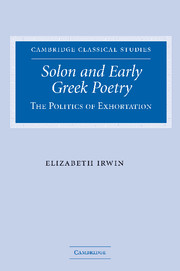Book contents
- Frontmatter
- Contents
- Acknowledgements
- List of abbreviations and editions
- Introduction
- PART I THE POLITICS OF EXHORTATION
- PART II POLITICAL POETICS: SOLON'S EUNOMIA
- Introduction
- 4 Solon 4 and martial poetry
- 5 Solon's Odyssey
- 6 Solon 4 and Hesiod
- PART III POETRY AND POLITICAL CULTURE
- Conclusion
- Appendix I Who were Tyrtaeus' gymnetes?
- Appendix II λυκάβαντος: when the wolf comes?
- Bibliography
- General index
- Index locorum
Introduction
Published online by Cambridge University Press: 05 November 2009
- Frontmatter
- Contents
- Acknowledgements
- List of abbreviations and editions
- Introduction
- PART I THE POLITICS OF EXHORTATION
- PART II POLITICAL POETICS: SOLON'S EUNOMIA
- Introduction
- 4 Solon 4 and martial poetry
- 5 Solon's Odyssey
- 6 Solon 4 and Hesiod
- PART III POETRY AND POLITICAL CULTURE
- Conclusion
- Appendix I Who were Tyrtaeus' gymnetes?
- Appendix II λυκάβαντος: when the wolf comes?
- Bibliography
- General index
- Index locorum
Summary
The three chapters of Part II offer a close analysis of the elegiac exhortation of Solon, and in particular focus on the detailed reading of one poem, 4, ἡμϵτϵ ´ρα δϵ´ πόλις (‘our city’), also known as ‘Solon's Eunomia’. There are several reasons for choosing this poem. Solon 4 invites discussion of the interface between poetry and politics: though the poem is general in its expression, the strong introduction, ‘Our polis’, as well as his heart's injunction to teach ‘the Athenians’ in line 30 clearly ground the poem in a political context. Moreover, Solon 4 invites in-depth analysis in relation to Callinus and, especially Tyrtaeus: not only is it the longest of Solon's political poems and in elegiacs, but it assumes a hortatory stance that situates it within a wider context of archaic exhortation elegy. Beyond its generic relationship to elegy, Solon 4 contains extended appropriations, both obvious and subtle, of hexametric poetry. But its choices of alignment and opposition to these influences show significant differences from the other elegists. And it is precisely these choices, it will be argued, that reflect more clearly than perhaps any other early poem how the poet's engagement with poetic tradition provides at the same time a dynamic reading of it, and one that involves the concerns – thematic and linguistic – of his contemporary audience.
In this poem Solon flags his debts and responses to his poetic predecessors in what scholars consider a transparent manner.
- Type
- Chapter
- Information
- Solon and Early Greek PoetryThe Politics of Exhortation, pp. 85 - 90Publisher: Cambridge University PressPrint publication year: 2005

